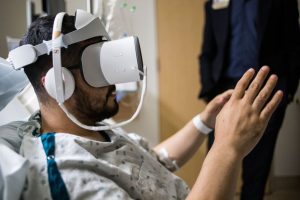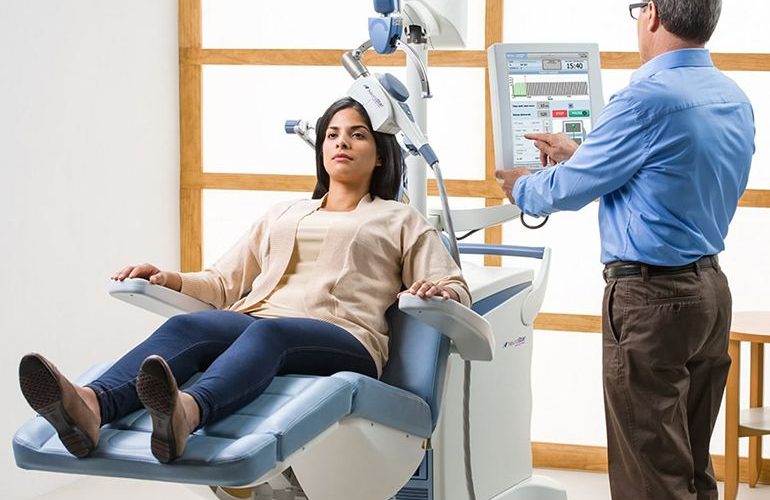Use of VR for Generalized Anxiety Disorder (GAD) and Social Anxiety
Anxiety disorders, such as Generalized Anxiety Disorder (GAD) and social anxiety, are some of the most common mental health conditions affecting people worldwide. Traditional treatments like cognitive-behavioral therapy (CBT) and medication are effective, but many individuals struggle with treatment adherence or find it difficult to confront their anxiety in real-life situations. This is where VR therapy offers a valuable alternative.
VR exposure therapy for anxiety disorders involves immersing patients in virtual environments that replicate the anxiety-inducing situations they fear. For example, someone with social anxiety might interact with virtual people in a simulated social setting. By gradually increasing the level of social interaction—from a small group to a large crowd—patients can learn to manage their anxiety in a controlled and safe environment. The goal is to help patients build confidence and learn coping strategies in real-life situations.
Another application of VR for anxiety is in virtual mindfulness and relaxation exercises. VR can be used to create peaceful environments, such as beaches, forests, or calming cityscapes, where patients can practice mindfulness and deep breathing. This has been shown to reduce stress and promote relaxation, offering immediate relief from anxiety symptoms.
Effectiveness of VR in Treating Depression

Creating Positive, Mood-Boosting Virtual Experiences
Depression is a debilitating mental health condition that affects millions of people around the world. While traditional treatments like medication and therapy are effective for many, there are still patients who struggle to manage their symptoms. VR offers a promising solution by providing immersive, positive experiences designed to improve mood and emotional well-being.
VR therapy for depression often involves creating virtual environments that are uplifting and calming. Patients might visit peaceful natural landscapes, explore calming urban settings, or even engage in activities like virtual gardening or art. These positive virtual experiences provide a mental escape and can help patients break free from negative thought patterns.
In addition to mood-boosting environments, VR can be used to guide patients through cognitive-behavioral therapy techniques that focus on challenging negative thoughts and improving emotional regulation. For example, virtual therapy sessions can involve exercises that encourage patients to reframe negative thinking patterns and develop healthier coping strategies.
Some VR programs for depression also include gamified elements, where patients can engage in virtual activities that promote a sense of achievement and satisfaction. This gamification aspect can be particularly motivating for individuals who struggle with low energy or lack of interest, which are common symptoms of depression.
VR in Treating Obsessive-Compulsive Disorder (OCD)
Exposure Therapy for OCD Patients
Obsessive-Compulsive Disorder (OCD) is another mental health condition that can be effectively treated with VR. OCD involves intrusive thoughts (obsessions) and repetitive behaviors or rituals (compulsions). The goal of VR therapy for OCD is to help patients confront their obsessions in a controlled way, allowing them to reduce compulsive behaviors over time.
In VR exposure therapy for OCD, patients are exposed to virtual scenarios that trigger their obsessive thoughts. For example, a person with contamination fears might virtually touch objects that are “contaminated” and resist the urge to wash their hands. The virtual exposure helps desensitize the patient to their obsessions, making it easier to resist the compulsive behaviors.
Research has shown that VR exposure therapy for OCD is highly effective. A study from the University of Southern California found that patients who underwent VR therapy for OCD reported significant reductions in symptoms, including fewer compulsive behaviors and less anxiety surrounding their obsessions.
Challenges and Limitations of VR Therapy
Potential Drawbacks or Risks of VR in Mental Health Treatment
While VR therapy shows immense promise, there are also challenges and limitations that need to be addressed. One of the primary concerns is accessibility. VR equipment can be expensive, and many patients may not have access to the necessary technology or facilities to participate in VR therapy. Additionally, not all patients are comfortable with VR or may experience motion sickness, which can hinder the effectiveness of therapy.
Another limitation is the need for specialized training. Therapists must be trained in using VR technology and integrating it into their treatment plans. This adds a layer of complexity to VR therapy and may limit its widespread adoption. Furthermore, VR therapy is still relatively new, and more research is needed to fully understand its long-term effects and potential risks.
Finally, VR therapy is not a one-size-fits-all solution. While many patients respond well to VR therapy, others may find it ineffective or challenging to engage with. It’s important that VR therapy be used as part of a broader treatment plan, rather than as a standalone solution.
The Future of VR in Mental Health Therapy

Ongoing Research and Advancements in VR Technology for Mental Health
The future of VR in mental health therapy looks promising, with ongoing research and advancements in VR technology. New developments in VR hardware and software are making it easier for therapists to create more immersive and interactive environments. Additionally, advances in artificial intelligence (AI) and machine learning are allowing VR therapy to be more personalized and adaptive to individual patients’ needs.
For example, AI can be used to adjust the intensity of exposure in real-time, based on the patient’s emotional responses, which enhances the effectiveness of therapy. This dynamic and responsive approach allows therapists to fine-tune treatment and ensure that patients are receiving the most effective intervention possible.
As VR technology continues to improve, it is expected that VR therapy will become more accessible, affordable, and widely adopted across different healthcare settings. This could lead to greater integration of VR into mainstream mental health care, offering a valuable tool for treating a range of mental health conditions.
Conclusion
In conclusion, the impact of Virtual Reality on mental health therapy is profound and holds great promise for the future of treatment. By providing immersive, controlled environments, VR allows patients to confront their fears, manage anxiety, reduce depression, and improve overall mental well-being. From treating phobias to helping veterans with PTSD, VR offers a powerful tool for enhancing traditional therapeutic approaches.
However, like any new technology, VR therapy has its challenges, including cost, accessibility, and the need for specialized training. Yet, with ongoing advancements in VR technology and a growing body of research supporting its effectiveness, VR is poised to play an increasingly important role in mental health care.
As the technology becomes more widely available and accessible, VR therapy could revolutionize the way we approach mental health treatment, offering patients new opportunities for healing and recovery.












